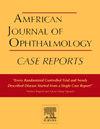费城染色体阳性急性淋巴细胞白血病患者尸检一例大疱性视网膜脱离和低视
Q3 Medicine
引用次数: 0
摘要
目的报告1例费城染色体阳性急性淋巴细胞白血病(Ph + ALL)并发大疱性视网膜脱离、低视及视盘肿胀的临床及病理特点。观察:65岁日本女性,双侧视力模糊。四年前,她被诊断为Ph + ALL,并接受了化疗。在最初的检查,光学相干断层扫描显示视网膜下脱离类似中央浆液性脉络膜视网膜病变。在1个月前的缓解期,当患者去诊所就诊时,也发现了类似的发现。视网膜下脱离在全身化疗后消失。5个月后,虽然完全缓解,但她出现单侧虹膜炎和右眼眼压升高,经局部类固醇治疗后有所改善。初次就诊10个月后,她双眼视力下降。裂隙灯检查显示右眼垂体性葡萄膜炎。眼底检查显示双侧大泡性视网膜脱离及视盘肿胀,以右眼更为明显。同时,骨髓活检证实急性淋巴细胞白血病复发。因此,开始全身和鞘内化疗;然而,她的病情恶化,两周后死亡。尸检显示白血病广泛浸润眼部组织,导致多种眼部表现。结果表明,眼球浸润可能是血源性的,也可能是从脑膜直接延伸而来。结论1例Ph + ALL患者在缓解期出现眼部表现,经病理证实为眼部白血病浸润。眼科评估对于确认ALL眼部复发至关重要,应密切监测患者,以便早期发现和及时干预。本文章由计算机程序翻译,如有差异,请以英文原文为准。
An autopsy case of bullous retinal detachment and hypopyon in a patient with Philadelphia chromosome-positive acute lymphoblastic leukemia
Purpose
To report the clinical and histopathological features of a case of bullous retinal detachment, hypopyon, and optic disc swelling in a patient with Philadelphia chromosome-positive acute lymphoblastic leukemia (Ph + ALL).
Observations
A 65-year-old Japanese woman presented with bilateral blurry vision. Four years earlier, she had been diagnosed with Ph + ALL and received chemotherapy. At initial examination, optical coherence tomography revealed subretinal detachment resembling central serous chorioretinopathy. A similar finding had been detected 1 month earlier during the remission phase, when the patient visited a clinic. Subretinal detachment resolved after systemic chemotherapy. Five months later, while in complete remission, she developed unilateral iritis and elevated intraocular pressure in the right eye, which improved with topical steroid treatment. Ten months after the initial presentation, she returned with decreased vision in both eyes. A slit-lamp examination revealed hypopyon uveitis in the right eye. Fundus examination revealed bilateral bullous retinal detachment and optic disc swelling, which was more pronounced in the right eye. At the same time, a bone marrow biopsy confirmed relapse of ALL. Therefore, systemic and intrathecal chemotherapy was initiated; however, her condition deteriorated, and she died 2 weeks later. Autopsy revealed widespread leukemic infiltration throughout the ocular tissues, resulting in multiple ocular manifestations. The findings suggested that ocular infiltration occurred either hematogenously or through direct extension from the meninges.
Conclusion
Leukemic infiltration of the eye was pathologically confirmed in a patient with Ph + ALL who developed ocular manifestations during the remission phase. Ocular evaluation is essential for confirming ocular relapse of ALL, and patients should be closely monitored to enable early detection and timely intervention.
求助全文
通过发布文献求助,成功后即可免费获取论文全文。
去求助
来源期刊

American Journal of Ophthalmology Case Reports
Medicine-Ophthalmology
CiteScore
2.40
自引率
0.00%
发文量
513
审稿时长
16 weeks
期刊介绍:
The American Journal of Ophthalmology Case Reports is a peer-reviewed, scientific publication that welcomes the submission of original, previously unpublished case report manuscripts directed to ophthalmologists and visual science specialists. The cases shall be challenging and stimulating but shall also be presented in an educational format to engage the readers as if they are working alongside with the caring clinician scientists to manage the patients. Submissions shall be clear, concise, and well-documented reports. Brief reports and case series submissions on specific themes are also very welcome.
 求助内容:
求助内容: 应助结果提醒方式:
应助结果提醒方式:


